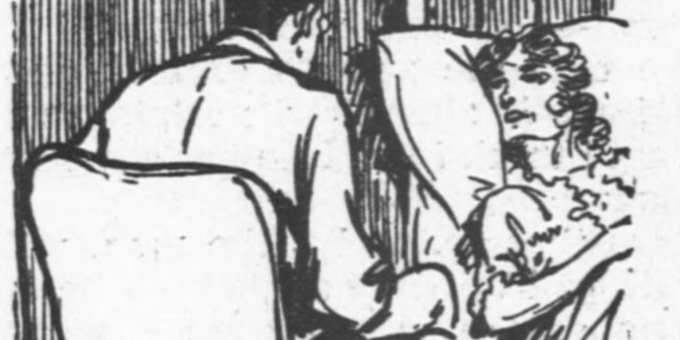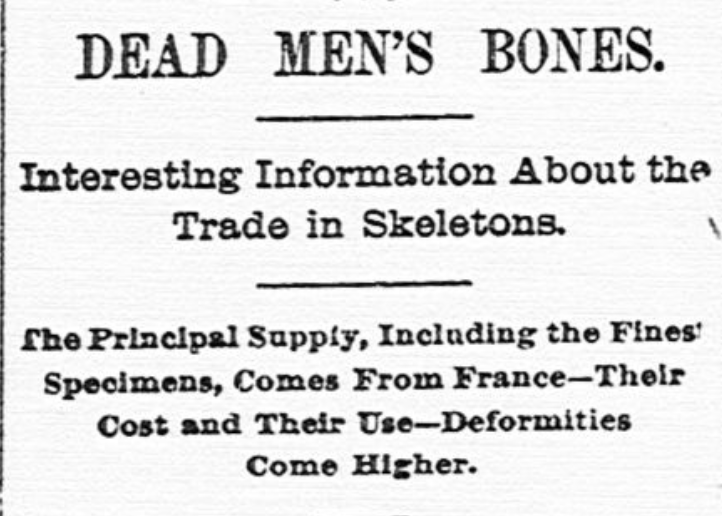
A previous article I put online discussed how Paris was the major exporter of human skeletons in the 1800s. In the article below, a doctor discusses the costs of these skeletons in the United States as well as who purchases the skeletons.
Dead Men’s Bones

Without rising, the doctor pulled a cord or touched a spring hidden somewhere in his close proximity. Instantly the door of a tall cabinet which stood in one corner of the room swung noiselessly open and disclosed a skeleton which hung from a ring fastened to the top of its skull. So unexpected was the sight of this ghostly apparition that the reporter started back with a little cry of surprise.
“Startled you a little, I see,” continued the doctor. “It isn’t a pleasant sight to one unaccustomed to it, but to me, anatomically speaking, as fine a specimen of Parisian art as that is a thing of beauty and a joy forever. But seriously, you as a non-professional man can have no adequate idea of how important to us doctors is the condition of the skeleton market. There is no branch of the enormous import trade of this country which is so interesting as the trade in skeletons. It is not the magnitude of the trade itself nor its importance that makes it so, but it attracts attention just because the article itself is so fascinating to the average man. Well can I remember how as a boy I used to go up in the garret of my father’s house, my father was also a physician, and at a safe distance gaze completely fascinated at a skull which had been relegated to that dusty retreat. How many romances did I build around that fragment of mortality. To me it was a thing that thoroughly aroused all the morbid imagination of my boyish nature.
“But to come back to the present. That skeleton which you see there is one of the finest examples of the French art and cost $125. Our great nation is entirely dependent upon foreign countries for its skeletons. To be sure here and there a physician may be found who possesses a specimen of home manufacture, but the stock of skeletons of the country are all imported. The man who mounts skeletons must be a skillful anatomist besides an experienced mechanic. He must know the position of every bone in the human anatomy and just where it goes. He must also know the function of each bone and be able to articulate them so skillfully that when wired they will move as naturally in their sockets as they did when acted upon by the muscles of the live being. An anatomist, for instance, however poor a one he might be, would know that to rest the butt of a heavily loaded gun against the middle of the collar bone and fire it would be an act of superlative folly. Collar bones were not made for such use. Now, although possessed of so much more knowledge than some sportsmen, the Parisian anatomist is willing and eager to work at about twenty-five cents a day, and his employer is thus able to ship skeletons to this country at a much lower rate than they can be made for even by a newly-fledged doctor.”
“Skeletons must be reasonably cheap then,” interpolated the reporter while the doctor was catching his breath for a fresh start.
“I should say they were. Incredible as it may seem, a well-mounted skeleton neatly packed in a pine case can be obtained for the moderate sum of $30. The case is made to stand on end and when stained admirably served the same purpose as does the more elaborate black walnut cabinet. Of course most physicians prefer a cabinet made of black walnut with glass doors covered with red curtains, but this is a matter of taste and pocket. I would not recommend a person, however, to invest his money in a $30 skeleton, unless for temporary or infrequent use. They are not substantial, they will to take a fine polish and are apt to crumble. You see the $30 skeletons are taken from the corpses of people well advanced in life when the calcareous matter predominates in the bones. Moreover some people have bones which are more brittle than those of others. The Paris workman can tell at a glance the condition of the bones upon which he is to work and knows how far he can carry the bleaching or whitening process upon the bones of any particular subject. This process tends to make brittle the bones. The skeleton of a young person which is of the right quality will stand a good deal of work and a great deal of work at even but twenty-five cents a day means an enhanced price. A first-class skeleton, which will stand for years the hard knocking about which it receives in a college lecture room, will cost $125. A skeleton of this quality has silver-plated wire articulations and every thing in accordance. Some men with an eye for the artistic will have a skeleton mounted with silver wire. This, however, is foolishly extravagant, nor is a skeleton so articulated as strong as one the joints of which are of steel.”
“Are there many importers of skeletons in this country?”
“There are six firms engaged in the business and between them there is a practical understanding by which prices are maintained. If you were to go into the salesrooms of Fibula & Co., and after picking out a skeleton that suited you, should intimate that one of the squamous sutures was not well, and that as Pubis & Co. were offering perfect specimens at a cost of $5 less, the salesman would raise his eyebrows, look at you in a mildly suspicious way and intimate that you were mistaken. He would add for your information that the goods were all marked in plain figures, were warranted, and that no reduction could be made.”
“For what grade of skeletons is the demand the greatest?”
“The ordinary demand for skeletons is like the demand in most branches of trade. Plain, substantial goods at moderate prices are what are most wanted. Strong, well whitened bones, well articulated, with polished steel at from $60 to $80, are in such demand that you couldn’t find a dozen, no, nor a half dozen, in the city at any one time, except perhaps just after the arrival of some French steamer, when a fresh importation might increase the stock temporarily. Not less than 500 of these skeletons are sold right here and in New York every year by the importing houses. In addition to this staple trade in ordinary skeletons, there is a steadily increasing demand for deformities. For instance, your skeleton with two fractures of the femur would bring perhaps $5 extra, but if accompanied by the certificate of a reputable physician like myself, stating how the bone was broken, an additional $10 would be asked for it. If, now, you were afflicted with curvature of the spine or some abnormal development of the foot or head, your skeleton might, it well mounted, bring as high as $175 to $200. There are cases of deformities that are so unusual as to make the skeleton the subject of still greater value.”
“What are skeletons mostly used for?”
“To illustrate lectures and adorn museums. Most physicians have one as an aid to research, and there is not a college graduate who has not a distinct recollection of the rattling subjects which, hung to a brass rod fastened to a stand, used to be wheeled into the classroom when the class in physiology was to recite. Secret societies also include in their stock of terrifying paraphernalia a skeleton. I well remember the experience that I had when being initiated into the awful mysteries of a lodge. With my eyes blindfolded I was led into a darkened room. All was silence and then a sepulchral voice uttered these words: ‘Friend, for I may not as yet call you brother, remember that the journey of life is now stretching before you. Meditate well on this thought, for in the midst of pleasures still they are but fleeting as the mist on the ocean. Man sometimes rises to eminence, but then again he falls’ – at this point I was precipitated from the end of a plank and fell upon a thick mattress, while the members of the lodge groaned together. I need not say what other trials awaited me, but at last, in order that I might be sufficiently terrified into keeping the secrets of the society, I was led into a closet, the hood dropped off and there before me was a grinning skeleton, the eyes of which shot out phosphorescent light from the blue fire playing within the skull. Then its right hand raised slowly and a melancholy voice proclaimed: ‘Beloved, I am thy fate!’ I didn’t scare worth a cent, though, for I recognized the skeleton as belonging to a fellow physician! You see it was one with peculiarly shaped transplanted teeth and I’d have known it among a thousand. I had to laugh when I thought of being frightened at such a thing as that.”
“You say that this skeleton had transplanted teeth; what do you mean by that?”
“I mean that the Paris anatomists select their bones from which they prepare their goods from job lots which perhaps have come from the different dissecting rooms or else from the catacombs. These bones are utilized to make cheap skeletons, the different parts of the frame being selected and fitted together so that one skeleton may contain the bones from several subjects. Talking of skeletons reminds me that veterinary surgeons are getting to be a very well educated class of men, and in their profession need about the same appliances for study that regular physicians do. There is a constantly increasing demand for skeletons of dogs and horses. The latter are regularly kept in stock, and can be had for from $125 to $150. Dog skeletons are usually made to order, and a $50 bill will buy a first-class one.”
Source: The Manning times. (Manning, Clarendon County, S.C.), 30 Jan. 1889.

